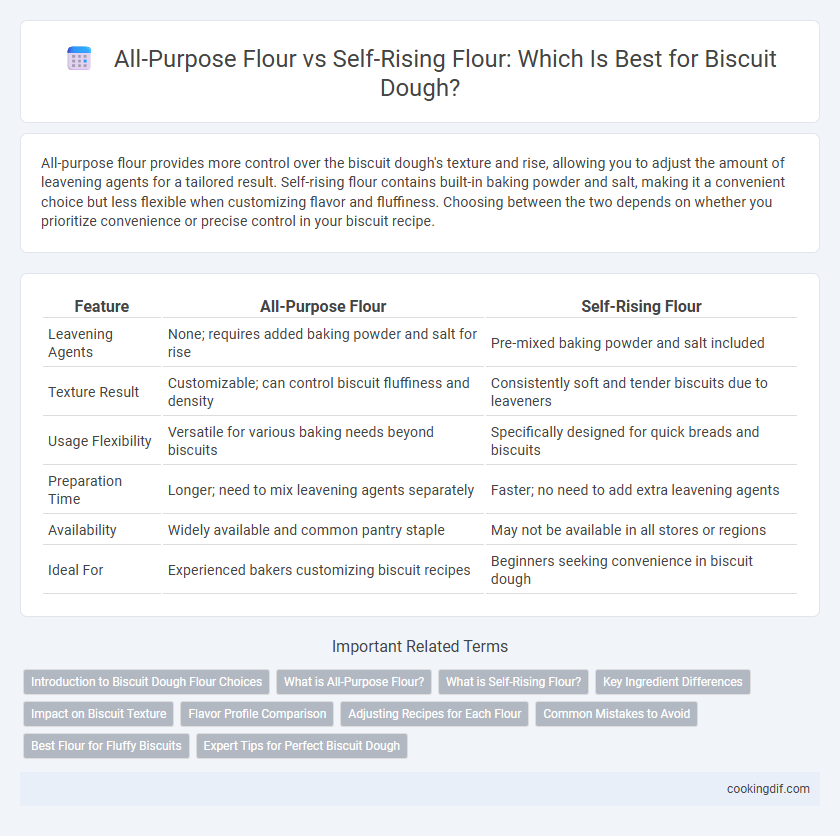All-purpose flour provides more control over the biscuit dough's texture and rise, allowing you to adjust the amount of leavening agents for a tailored result. Self-rising flour contains built-in baking powder and salt, making it a convenient choice but less flexible when customizing flavor and fluffiness. Choosing between the two depends on whether you prioritize convenience or precise control in your biscuit recipe.
Table of Comparison
| Feature | All-Purpose Flour | Self-Rising Flour |
|---|---|---|
| Leavening Agents | None; requires added baking powder and salt for rise | Pre-mixed baking powder and salt included |
| Texture Result | Customizable; can control biscuit fluffiness and density | Consistently soft and tender biscuits due to leaveners |
| Usage Flexibility | Versatile for various baking needs beyond biscuits | Specifically designed for quick breads and biscuits |
| Preparation Time | Longer; need to mix leavening agents separately | Faster; no need to add extra leavening agents |
| Availability | Widely available and common pantry staple | May not be available in all stores or regions |
| Ideal For | Experienced bakers customizing biscuit recipes | Beginners seeking convenience in biscuit dough |
Introduction to Biscuit Dough Flour Choices
All-purpose flour and self-rising flour differ significantly in their impact on biscuit dough texture and rise. All-purpose flour provides a versatile, moderate protein content that allows control over leavening agents, while self-rising flour contains pre-added baking powder and salt, streamlining the recipe but limiting ingredient customization. Choosing between these flours affects the biscuit's fluffiness, tender crumb, and overall flavor profile.
What is All-Purpose Flour?
All-purpose flour is a versatile wheat flour that contains moderate protein levels, typically around 10-12%, making it suitable for a wide range of baked goods, including biscuits. It lacks any added leavening agents, so recipes using all-purpose flour require separate baking powder or baking soda to achieve proper rise and texture. This flour provides a balanced structure resulting in tender, flaky biscuits when combined with the correct mixing and rising agents.
What is Self-Rising Flour?
Self-rising flour is a pre-mixed blend of all-purpose flour, baking powder, and salt specifically designed to help baked goods like biscuits rise without needing additional leavening agents. This flour simplifies biscuit dough preparation by ensuring consistent texture and lift, ideal for quick baking. Compared to all-purpose flour, which requires manual addition of baking powder and salt, self-rising flour offers convenience and uniform results in biscuit recipes.
Key Ingredient Differences
All-purpose flour contains only wheat flour, making it a versatile base for biscuit dough that requires separate leavening agents like baking powder or baking soda. Self-rising flour combines wheat flour with a pre-measured amount of baking powder and salt, providing built-in leavening that simplifies the biscuit-making process. The key ingredient difference influences texture, rise, and flavor, with all-purpose flour offering more control over leavening while self-rising flour ensures consistent results with less effort.
Impact on Biscuit Texture
All-purpose flour creates a denser, chewier biscuit texture due to its moderate protein content, which develops gluten more robustly. Self-rising flour, pre-mixed with baking powder and salt, produces lighter, fluffier biscuits by providing consistent leavening and a softer crumb structure. Choosing between these flours directly influences biscuit height, tenderness, and overall mouthfeel.
Flavor Profile Comparison
All-purpose flour provides a neutral base allowing the rich buttery flavor of biscuits to shine, while self-rising flour adds a slightly tangy note due to the baking powder and salt content. Baking powder in self-rising flour can impart a subtle chemical taste that may alter the traditional flavor profile of classic biscuits. Choosing all-purpose flour offers more control over seasoning, enhancing the overall savory and comforting taste of biscuit dough.
Adjusting Recipes for Each Flour
Using all-purpose flour in biscuit dough requires adding baking powder and salt to replicate the leavening and flavor agents naturally present in self-rising flour. Adjusting recipes involves reducing or eliminating added baking powder and omitting salt when using self-rising flour to maintain proper texture and taste. Accurate measurement of these ingredients ensures consistent biscuit rise and a tender crumb regardless of the flour choice.
Common Mistakes to Avoid
Using all-purpose flour instead of self-rising flour in biscuit dough without adding baking powder and salt often results in dense, flat biscuits due to insufficient leavening. Another common mistake is overmixing the dough when using self-rising flour, which can lead to tough, chewy biscuits instead of light, flaky ones. Ensuring accurate measurements and understanding the leavening properties of each flour type is critical to achieve the desired biscuit texture and rise.
Best Flour for Fluffy Biscuits
All-purpose flour provides the ideal balance of protein and texture for biscuit dough, resulting in tender yet sturdy biscuits. Self-rising flour contains added baking powder and salt, which can cause biscuits to rise too quickly and unevenly, compromising fluffiness. For the best fluffy biscuits, using all-purpose flour with separate leavening agents allows for better control over texture and rise.
Expert Tips for Perfect Biscuit Dough
All-purpose flour provides the ideal protein content for tender biscuit dough, allowing for better control over texture and rise compared to self-rising flour, which already contains baking powder and salt. Experts recommend using all-purpose flour with a measured amount of baking powder and salt to customize leavening and achieve consistent biscuit fluffiness. Maintaining a light hand when mixing and incorporating cold butter ensures flaky layers and prevents tough dough, regardless of flour choice.
All-purpose flour vs self-rising flour for biscuit dough Infographic

 cookingdif.com
cookingdif.com